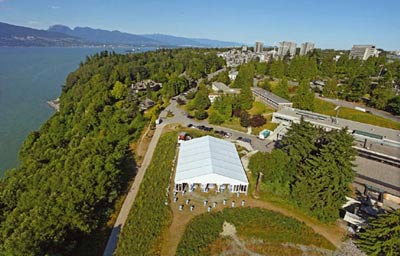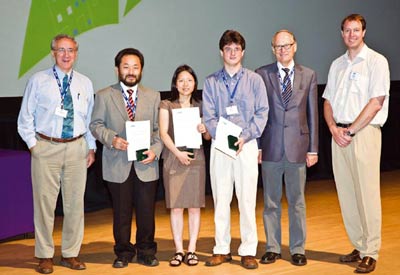The INPC 2010 meeting reveals a healthy and dynamic research field.

Image credit: Mike Clegg/Photo Blimp Photography.
The 25th International Nuclear Physics Conference (INPC) took place on 4–9 July at the University of British Columbia, hosted by TRIUMF, Canada’s national laboratory for particle and nuclear physics in Vancouver. As the main conference in the field, this triennial meeting is endorsed and supported by the International Union for Pure and Applied Physics (IUPAP). This year it attracted more than 750 delegates – including 150 graduate students – from 43 countries and covered topics in nuclear structure, reactions and astrophysics; hadronic structure, hadrons in nuclei and hot and dense QCD; new accelerators and underground nuclear-physics facilities; neutrinos and nuclei; and applications and interdisciplinary research. Participants found many opportunities to connect with fellow nuclear physicists from across the globe. At conferences such as the INPC, which span an entire discipline, many unexpected links emerge, often leading to fruitful new discussions or collaborations.
Impressive progress
INPC 2010 opened with an afternoon public lecture by Lawrence Krauss of Arizona State University. In his talk, “An atom from Vancouver”, the renowned cosmologist and public speaker gave a broad perspective on why nuclear physics is key to a deeper understanding of how the universe was formed, as well as the birth, life and death of stars. The next morning, Peter Braun-Munzinger of GSI opened the scientific plenary programme with a talk that highlighted progress since the previous INPC in Tokyo in 2007, with theoretical and experimental examples from around the world. All topics at the conference were then well represented in both the plenary programme and the well attended afternoon parallel programme, where more than 250 invited and contributed talks were presented, as well as more than 380 posters. The poster presentations were among the most lively of the sessions, with many graduate students and post-doctoral fellows participating.
The scientific high points included the presentations in the field of hot and dense QCD, which reported on experimental and theoretical progress at Brookhaven’s Relativistic Heavy Ion Collider. The session on nuclear reactions provided highlights from many new and exciting facilities, including the Radio Isotope Beam Factory at the RIKEN centre in Japan, as well as an outlook of what can be expected from the Facility for Antiproton and Ion Research in Germany and the Facility for Rare Isotope Beams in the US. The quest towards the “island of stability” in the superheavy-element community is still ongoing, and new progress was reported with the identification of element 114.
There is also impressive progress being made in the theoretical sector, in particular with new ab initio approaches to calculations. Applications of these methods and progress in nucleon–nucleon interactions, where three-body interactions are now considered state of the art, were presented in the sessions on nuclear structure. The predictions of such calculations can be tested by experiments, for example laser experiments and ion-trap measurements give access to the ground-state properties of exotic nuclei. In-beam or in-flight experiments pave the way to even more exotic isotopes, where new magic numbers for the nuclear-shell model are appearing. This will also prove relevant for nuclear astrophysics, where there has been significant experimental progress with new measurements of direct-capture reactions using rare-isotope beams and background-suppressed facilities located in underground laboratories. Presentations in this field also covered research on neutron stars and new results from the modelling of core-collapse supernovae, which clearly indicate the need for neutrino interactions to be included.
Neutrinos played a large role in other sessions, for example on new facilities, where progress from the deep underground facilities was presented, together with other exciting new projects. The first results from long-baseline oscillation experiments show progress in this field, while double-beta-decay experiments are coming close to first results. These are keenly awaited not only by the community of nuclear physicists but by many others as well.
The sessions on fundamental symmetry are always one of the highlights of the INPC series, where tests of the Standard Model using atomic nuclei or nuclear physics methods can probe sectors complementary to those investigated by large particle-physics experiments, for example in experiments that measure atomic and neutron electric-dipole moments. Recent progress was reported in nuclear beta decay in the context of the testing of the unitarity of the Cabibbo–Kobayashi–Maskawa matrix, as well as measurements of the mass of the W-boson and the weak mixing-angle. Talks on the muon anomalous magnetic moment and its sensitivity for probing “new physics” showcased the burgeoning activity in this field.
One of the keenly anticipated presentations was given in a session on hadron structure, in which the collaboration that has measured the Lamb shift in muonic hydrogen at the Paul Scherrer Institute presented their results. Their measurement of the rms charge radius of the proton indicates a 5σ deviation from the established value, spawning a flurry of new experimental and theoretical activity.

Image credit: Mindy Hapke/TRIUMF.
The conference also featured discussions on the growing importance of nuclear physics in near-term societal and economic arenas. David Dean of the US Department of Energy shared an interesting perspective on the future of the field in relation to growing concerns about energy production and consumption. From India, Swaminathan Kailas of the Bhabha Atomic Research Centre talked about the utilization of nuclear technologies in the development of thorium-based nuclear reactors. Andrew Macfarlane of the University of British Columbia described the application of nuclear physics to probing magnetic behaviours at the nanoscale level in regimes relevant for condensed-matter physics.
The large programme of the oral and poster sessions was extended to include special presentations by the winners of the IUPAP Young Scientist prizes, which are awarded in the field of nuclear physics every three years during the INPC conference. This year’s winners were: Kenji Fukushima of the Yukawa Institute for Theoretical Physics, Kyoto University; Peter Müller of Argonne National Laboratory; and Lijuan Ruan of Brookhaven National Laboratory. These three researchers represent the future excellence in nuclear physics, in the fields of theoretical QCD, precision experiments in low-energy nuclear-halo physics and experimental techniques related to quark-gluon plasma.
The organizers of INPC 2010 made a special effort to attract many graduate students and post-doctoral fellows to the conference. For example, TRIUMF combined its traditional summer school with the US National Science Foundation’s summer school for nuclear physics, directly prior to the conference. This not only allowed the school to recruit some of the INPC delegates as lecturers, but also gave students a broad overview of the field of nuclear physics before the conference. In addition, INPC 2010 teamed up with Nuclear Physics A to provide awards for the best student oral presentation and the top three poster presentations at the conference. An international panel of judges together with members from the editorial board of Nuclear Physics A decided on the following award winners from a strong field of applicants: Paul Finlay (Guelph) for oral presentation; Young Jin Kim (Indiana), Evan Rand (Guelph) and Thomas Brunner (Munich) for posters.
A treat of a different kind awaited delegates at the conference banquet at Vancouver’s famous Museum of Anthropology. Olivia Fermi, the grand-daughter of the famed nuclear physicist Enrico Fermi, was among the guests and in the after-dinner speech she shared anecdotes from her life growing up in the Fermi household. The first-nation artefacts and art pieces, together with the museum’s setting overlooking the Pacific Ocean and the skyline of Vancouver, made this venue a perfect fit to a very special conference. The field clearly presented itself in a healthy and dynamic state, with many young people eagerly anticipating the advent of new experiments, theory and facilities. At the end of the conference, IUPAP announced the location of the next in the series, which will be held in Florence in 2013.
• For more about the full programme and presentations, see http://inpc2010.triumf.ca/.







